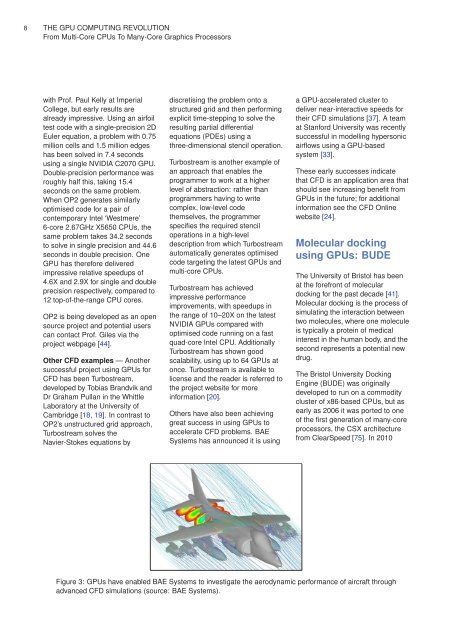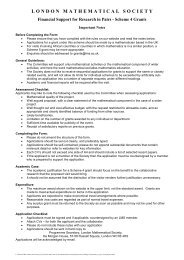The GPU Computing Revolution - London Mathematical Society
The GPU Computing Revolution - London Mathematical Society
The GPU Computing Revolution - London Mathematical Society
- No tags were found...
You also want an ePaper? Increase the reach of your titles
YUMPU automatically turns print PDFs into web optimized ePapers that Google loves.
8 THE <strong>GPU</strong> COMPUTING REVOLUTIONFrom Multi-Core CPUs To Many-Core Graphics Processorswith Prof. Paul Kelly at ImperialCollege, but early results arealready impressive. Using an airfoiltest code with a single-precision 2DEuler equation, a problem with 0.75million cells and 1.5 million edgeshas been solved in 7.4 secondsusing a single NVIDIA C2070 <strong>GPU</strong>.Double-precision performance wasroughly half this, taking 15.4seconds on the same problem.When OP2 generates similarlyoptimised code for a pair ofcontemporary Intel ‘Westmere’6-core 2.67GHz X5650 CPUs, thesame problem takes 34.2 secondsto solve in single precision and 44.6seconds in double precision. One<strong>GPU</strong> has therefore deliveredimpressive relative speedups of4.6X and 2.9X for single and doubleprecision respectively, compared to12 top-of-the-range CPU cores.OP2 is being developed as an opensource project and potential userscan contact Prof. Giles via theproject webpage [44].Other CFD examples — Anothersuccessful project using <strong>GPU</strong>s forCFD has been Turbostream,developed by Tobias Brandvik andDr Graham Pullan in the WhittleLaboratory at the University ofCambridge [18, 19]. In contrast toOP2’s unstructured grid approach,Turbostream solves theNavier-Stokes equations bydiscretising the problem onto astructured grid and then performingexplicit time-stepping to solve theresulting partial differentialequations (PDEs) using athree-dimensional stencil operation.Turbostream is another example ofan approach that enables theprogrammer to work at a higherlevel of abstraction: rather thanprogrammers having to writecomplex, low-level codethemselves, the programmerspecifies the required stenciloperations in a high-leveldescription from which Turbostreamautomatically generates optimisedcode targeting the latest <strong>GPU</strong>s andmulti-core CPUs.Turbostream has achievedimpressive performanceimprovements, with speedups inthe range of 10–20X on the latestNVIDIA <strong>GPU</strong>s compared withoptimised code running on a fastquad-core Intel CPU. AdditionallyTurbostream has shown goodscalability, using up to 64 <strong>GPU</strong>s atonce. Turbostream is available tolicense and the reader is referred tothe project website for moreinformation [20].Others have also been achievinggreat success in using <strong>GPU</strong>s toaccelerate CFD problems. BAESystems has announced it is usinga <strong>GPU</strong>-accelerated cluster todeliver near-interactive speeds fortheir CFD simulations [37]. A teamat Stanford University was recentlysuccessful in modelling hypersonicairflows using a <strong>GPU</strong>-basedsystem [33].<strong>The</strong>se early successes indicatethat CFD is an application area thatshould see increasing benefit from<strong>GPU</strong>s in the future; for additionalinformation see the CFD Onlinewebsite [24].Molecular dockingusing <strong>GPU</strong>s: BUDE<strong>The</strong> University of Bristol has beenat the forefront of moleculardocking for the past decade [41].Molecular docking is the process ofsimulating the interaction betweentwo molecules, where one moleculeis typically a protein of medicalinterest in the human body, and thesecond represents a potential newdrug.<strong>The</strong> Bristol University DockingEngine (BUDE) was originallydeveloped to run on a commoditycluster of x86-based CPUs, but asearly as 2006 it was ported to oneof the first generation of many-coreprocessors, the CSX architecturefrom ClearSpeed [75]. In 2010Figure 3: <strong>GPU</strong>s have enabled BAE Systems to investigate the aerodynamic performance of aircraft throughadvanced CFD simulations (source: BAE Systems).



